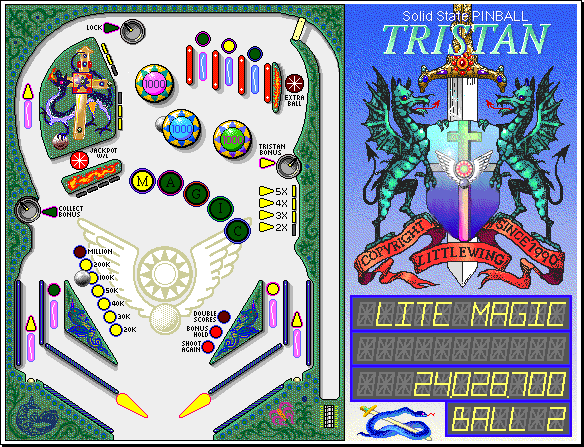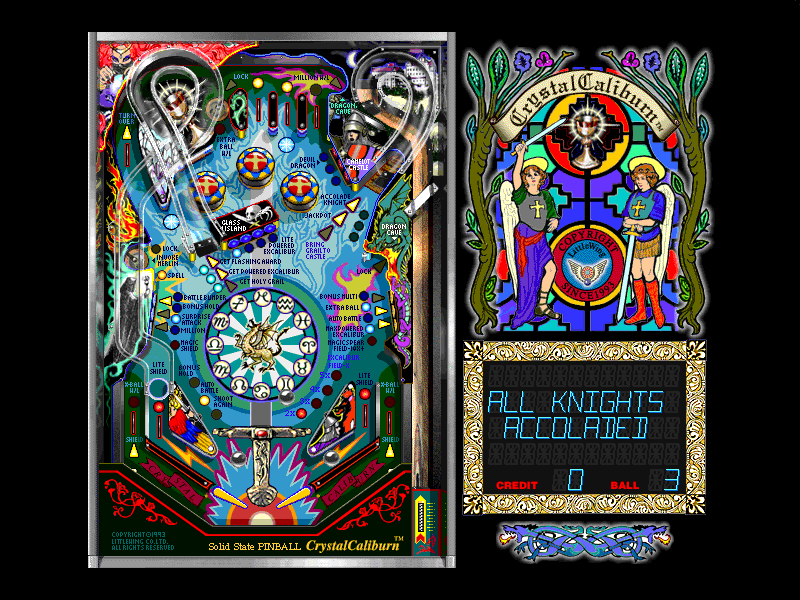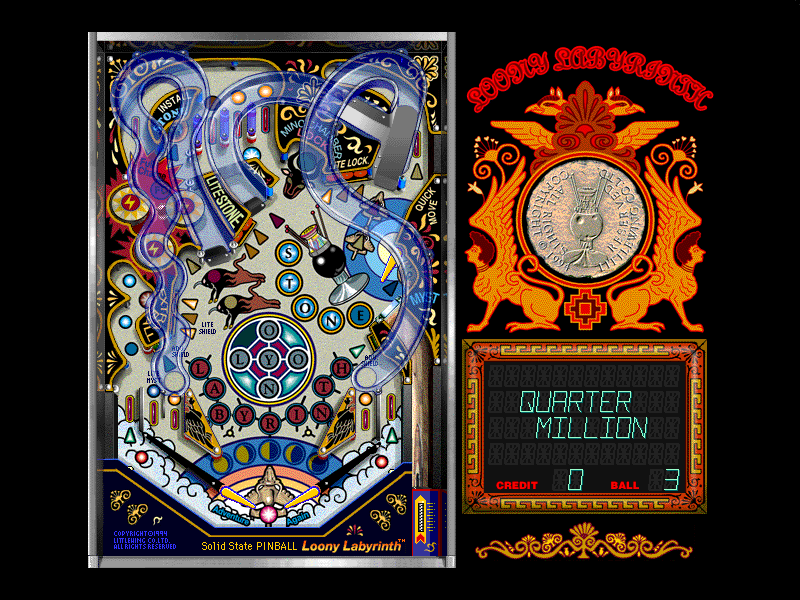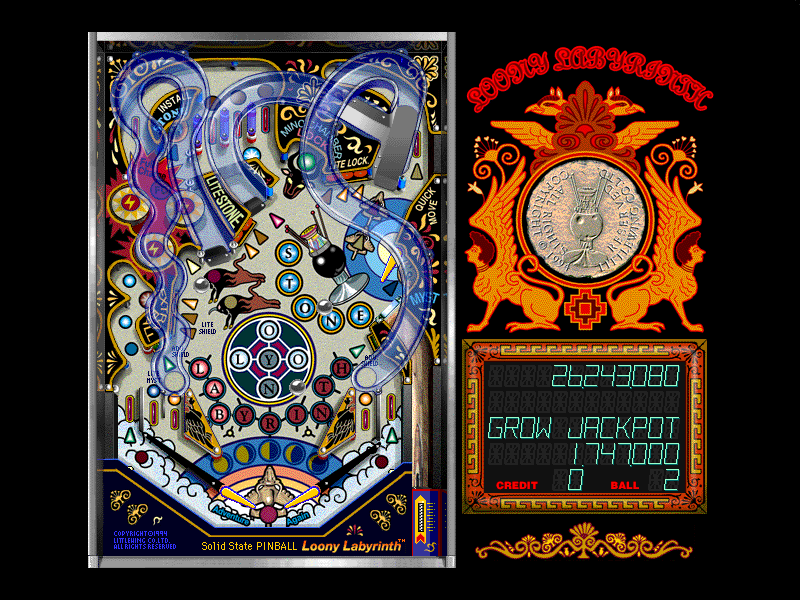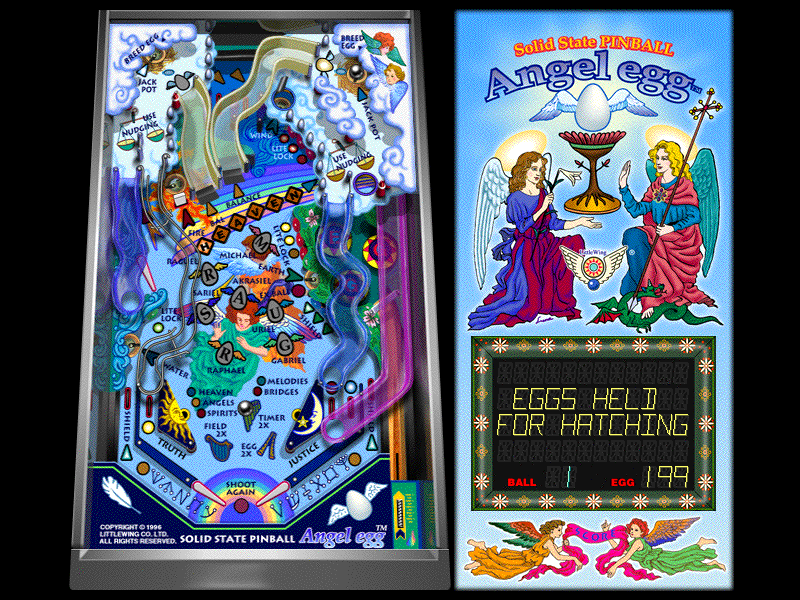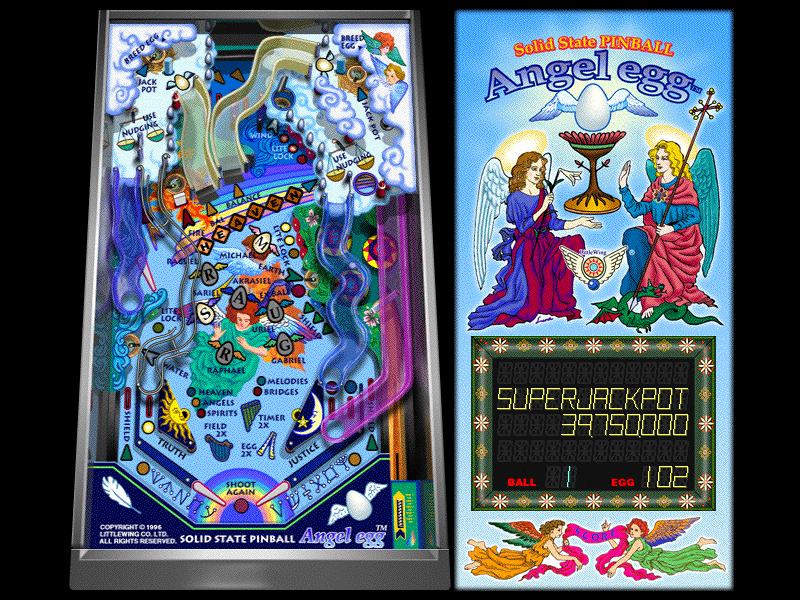LittleWing Pinball - Introduction
Japanese Mac games are a rare find. They exist, but very few of them are documented on western Macintosh archives and even fewer have translations. Retro Mac games are too obscure and inaccessible to get the same level of fan translations that games on more easily emulated platforms are blessed with. LittleWing stands out in my mind because of this, being a small development team in Japan dedicated to creating realistic pinball sims for Macintosh computers, whose work was officially translated and fairly widespread. Well, widespread by 90s Mac shareware standards, anyway. LittleWing made pinball sims for a solid 20 years and over time they perfected their craft. Going through their library in chronological order, you can see how their design and technical prowess evolved over time. LittleWing's games start out rough, but with each game they manage to one up themselves a little more, refine the aspects that didn't work quite right and expand the scope of their tables' designs. Not counting licensed games, LittleWing made nine original pinball tables over the course of their career. So, let's have a look over the first four of those nine games, see where they started and where they end up!
Tristan - LittleWing Pinball - 1991 - First time playing?: Yes!
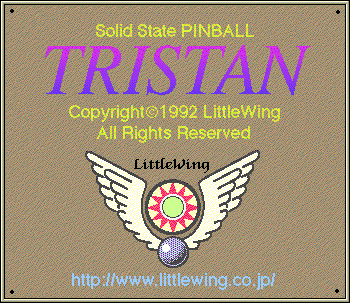
Starting off with their very first game, Tristan sure as hell feels like their first game. This is actually the only game we're looking at that is still Apple exclusive and never got a PC port, but honestly other than historical value there's not much to see here, so don't feel the need to set up a virtual machine for this one. There's no music, the table is simplistic and the physics are honestly pretty dreadful. Three years before Tristan, Alien Crush on the PC Engine managed to pull off realistic pinball physics a lot better than this game, and Alien Crush wasn't even aiming for realism. Tristan's ball moves sluggishly and is extremely floaty, which while not unplayable still results in a lot of the satisfaction of pinball being lost. This is always a sticking point with pinball video games, especially early ones like this. It's not impossible but definitely difficult to convey the weight of that metal ball and the satisfying impact of violently smashing it against bumpers and targets and slingshots, but Tristan's pinball feels more like a balloon with the way it gently bounces off of solid objects.
The worst aspect of the control in these early LittleWing releases in my opinion is down to the flippers themselves. I get what the devs were going for here, physical pinball tables have a rubber coating on the flippers, resulting in them having a little more friction than the harder surfaces of the ramps and orbits. Tristan tried to recreate this, but went way overboard and made the flippers feel more like velcro than rubber. The ball loses all speed when on the flippers and moves extremely jittery and is prone to bouncing off entirely without you even touching the flipper buttons, making it a pain to accurately aim at anything with. The speed of the ball is an important aspect of aiming your shots, it needs to be considered when timing your flipper usage, so it's a lot harder to aim when the speed of the ball is so inconsistent and off putting the second it touches the flippers. This also prevents real world pinball techniques such as ski jumping between flippers. Something else that is impossible here is slap saves, a real world pinball technique that involves nudging the table to prevent the pinball from going straight down the middle between the flippers. In Tristan there's only one nudge button and it can only nudge up, and very weakly at that too. No nudging the table left or right here unfortunately.
As for the table itself, it's pretty sparse and simplistic. Tristan feels more akin to table designs from the 50s and 60s by Gottleib rather than the more contemporary 80s and 90s pinball tables by Bally and Williams. There's no ramps or loops or anything like that, just some bumpers and a few targets to hit. There's not really a main objective to strive towards the same way other pinball tables have, the closest this game has to a wizard mode is just activating multiball, which is also a little underwhelming as it only gives you two balls, not three. During multiball you can get the jackpot if you manage to hit that awkwardly placed jackpot light, which can only be hit by bouncing off the bumper to the right of the light
There's actually some charm in the simplicity of Tristan, it's fun seeing a digital interpretation of pinball tables several decades older than the video game medium. Given the awkward physics, the simplicity of the table is actually a blessing that prevents the game from getting too frustrating. Regardless though, you'll see and experience everything that Tristan has to offer within a few minutes, it really doesn't have the longevity of LittleWing's future titles.
Crystal Caliburn - LittleWing Pinball - 1993 - First time playing?: No, played as a kid

In many ways, Crystal Caliburn feels like an expansion of the blueprints set in place by Tristan. There's quite a few similarities in table layout and mechanics, but vastly built upon to bring the table design up to the standards of tables from the 80s to 90s. The physics have been improved but many of the same hangups unfortunately persist, such as the sticky velcro flippers and the single nudge button. The ball does however have a bit more speed and weight to it, and thanks to improved sound effects there's more impact to everything you're batting the ball into as well.
There's an actual story and main objective this time, though it's still pretty simplistic. Your goal is to summon the twelve knights of the round table and then find the holy grail and take it back to Camelot. In order to summon a knight you must hit the top right loop after lighting the "ACCOLADE KNIGHT" arrow at the base of the loop. Basically doing anything else on the table will light that arrow, such as hitting the left loop, hitting the targets to the left and right of the table or lighting up Glass Island. The knights are represented by the zodiac symbols surrounding the dragon in the centre of the table. Once you've got them all you can get the grail, but good luck with that shot. You need to hit the left loop and then immediately afterwards hit the right loop, within five seconds. If you don't do it in time you lose the grail and have to collect it again. This would be manageable if not for those sticky velcro flippers. Losing all of your knights under most circumstances if you lose a ball doesn't help either.
Thankfully, there's plenty of other ways to rack up tons of points. Multiballs (now with three balls as opposed to just two), jackpots and multipliers can all be exploited for even more points. Multiball is achieved by hitting the devil dragon targets next to the bumpers, which activates the ball lock in the dragon cave. Once three balls are locked in the cave it's time for multiball, during which you can get the jackpot by hitting the same loop you use to summon knights. It helps the game feel less one note, as going for the grail does essentially just mean hitting that same right loop again and again to get more knights, though it does result in the table feeling even more like Tristan. There's more complexity here however, the table is loaded with far more toys to play with than Tristan's sparse few targets.
Crystal Caliburn is absolutely a big improvement. The table is more interesting, the pixel art is beautifully detailed, there's music and much more varied sound effects and it's all around a much more intense and exciting game. At the same time however it doesn't feel like it quite went far enough, and like the aspects of Tristan that it did decide to hold onto are holding it back.
Loony Labyrinth - LittleWing Pinball - 1994 - First time playing?: Yes!

Loony Labyrinth is quite a thematic departure from the Arthurian legend theme of the first two LittleWing games, but honestly it kinda rules. It's a game about an archaeologist who finds an ancient Greek labyrinth from 2000BC which holds a time machine that you must power up in order to go back in time to to the ancient yet technologically advanced Minos civilisation when the time machine was made, where you must kill a man-made bioweapon minotaur that has rebelled against humanity and now demands yearly sacrifices from his labyrinth. This is rad as hell, I need a Loony Labyrinth JRPG, this premise is too hype to be restricted to an obscure 90s Mac pinball game. At the same time however, this is part of what I love about pinball, the way it can use the basic flipper and ball mechanics to tell creative stories through an unconventional medium. I think that the fact that I want more out of this premise is actually a really positive sign. The energy of Loony Labyrinth is honestly infectious, from its outlandish story and its hammy announcer giving running commentary (a first for LittleWing that would later become a staple) and the ridiculously funky background music that is just the right amount of cheesy and unironically catchy.
I definitely like Loony Labyrinth more than Crystal Caliburn, but that's mostly just down to the creative premise and the table design. In terms of the engine and the physics and controls and general gameplay, it's almost identical to Crystal Caliburn. I did have an easier time aiming the ball in Loony Labyrinth for what that's worth, though I don't think that's really because of improved physics and more just because the most essential targets are in easier to hit locations. The main objective is a bit more involved too, as opposed to Crystal Caliburn basically just being about hitting that same loop repeatedly. Here you've got multiple objectives from the start, collecting the five stones required to activate the time machine by hitting the two targets below the "LITE STONE" text on the table and then hitting the loop just above those two targets, and also generating enough electricity to power the machine, achieved by hitting the bumpers. You also have two ways of achieving multiball here, either by lighting up the "LOONY" letters by hitting the right S-shaped ramp which immediately activates multiball, or by locking three pinballs in the minotaur chamber by hitting the targets to the right of the chamber's entrance. This is also the first LittleWing game to have more than two flippers, Loony Labyrinth's table having a flipper up in the top right which is used to hit the loop that gets you the stones.
While not a huge leap in technical aspects like physics and visuals, Loony Labyrinth is absolutely a step forward in table design and creativity that's worth respecting. It really is a shame that the physics are still iffy, I would wholeheartedly recommend this if not for those bizarre velcro flippers making control feel far more jittery than it should be. I would have loved to see this one get remade in the Angel Egg engine. Speaking of…
Angel Egg - LittleWing Pinball - 1996 - First time playing?: Yes!

I can not overstate what a massive leap in quality Angel Egg is in every regard. Physics, control, table design and visuals, LittleWing finally mastered their craft here and made a damn good pinball sim. Not only that, but it’s also very unique both in theme and mechanics. While not as wildly outlandish as the wacky time travel archaeology adventures of Loony Labyrinth, the playful biblical theme of Angel Egg still stands out for sure. I don't think I've ever seen a pinball table be so overtly religious like Angel Egg is, and despite this doll having chosen the side of the demons when it comes to spirituality, I still found the theme very charming and fun. The angels in this game blaspheme and cry out "Oh my God!" when you lose a multiball, I can't help but be endeared by that.
Your objective is to summon the seven archangels in order to begin Genesis and create the earth. In order to do this you need to collect angel eggs, which are earned by doing basically anything on the table, all bumpers and ramps and loops giving you eggs. Once you have enough eggs, the amount you need varies depending on how many archangels you already have summoned, you can launch the ball into one of the two breeding holes to hatch the eggs and summon the archangel. Progression in Angel Egg is far less linear than the previous games as a result, it's not a case of hitting the same ramps over and over again to light up more of the table, you can use all of the features of the table to get more eggs and get closer to summoning your next archangel.
Of course, when you need hundreds of eggs, you may find that with a single ball you're earning those eggs rather slowly, which is where multiball comes in. Angel Egg is very multiball focused and it's much easier to begin multiball to reflect that. Any time you summon an archangel another ball is added to the game, but you can also summon elemental spirits to add more balls to the table. There's four spirit holes in total; wind, water, fire and earth, each of which has targets tied to it which activates the ball locking mechanism within the hole once they're hit. The second you lock a ball in a spirit hole, a new ball is immediately added to the table. You can have up to six pinballs on the table at once, and with it being easier and quicker to begin multiball in Angel Egg you'll find that most of your play time is spent with more than a single ball on the table. Once again, jackpots are earned during multiball as well, everything that scores you big points is tied to keeping multiball going as long as possible.
On a technical level, it's absolutely night and day between Angel Egg and its predecessors. The physics are much better, the speed and weight once again feeling just that little bit closer to actual pinball, but most importantly, they finally fixed the weird traction on the flippers. The ball will now smoothly roll down on the flippers without any jittery bumping, as it should be, and as a result it is miles easier to actually aim your shots. The flippers can still slow down the momentum of the ball, but only if the ball is already rolling slowly enough for it to be affected by the flippers' traction, and it's a much smoother and more gradual loss of speed versus the 100 to 0 sudden momentum killing of LittleWing's past games. Furthermore, you finally have multiple dedicated buttons for nudging the table left and right, allowing for much more control over the ball. The table is even designed specifically with those new nudging controls in mind, with the upper tables even saying to use nudging to guide the ball down the path you want.
In my personal opinion, Angel Egg is absolutely the turning point in LittleWing's career. This one easily holds up and is still worth playing today thanks to its unique theme and mechanics in addition to its vastly improved technical aspects. Over the course of these four games, LittleWing consistently one upped themselves with every table they made, going from charming but janky games that were impressive for the time to one of my new favourite digital pinball games. If the next five games live up to the quality of Angel Egg, we'll have an absolutely superb lineup next time we visit LittleWing's library.
- Page written by MSX_POCKY, 2nd July 2023

